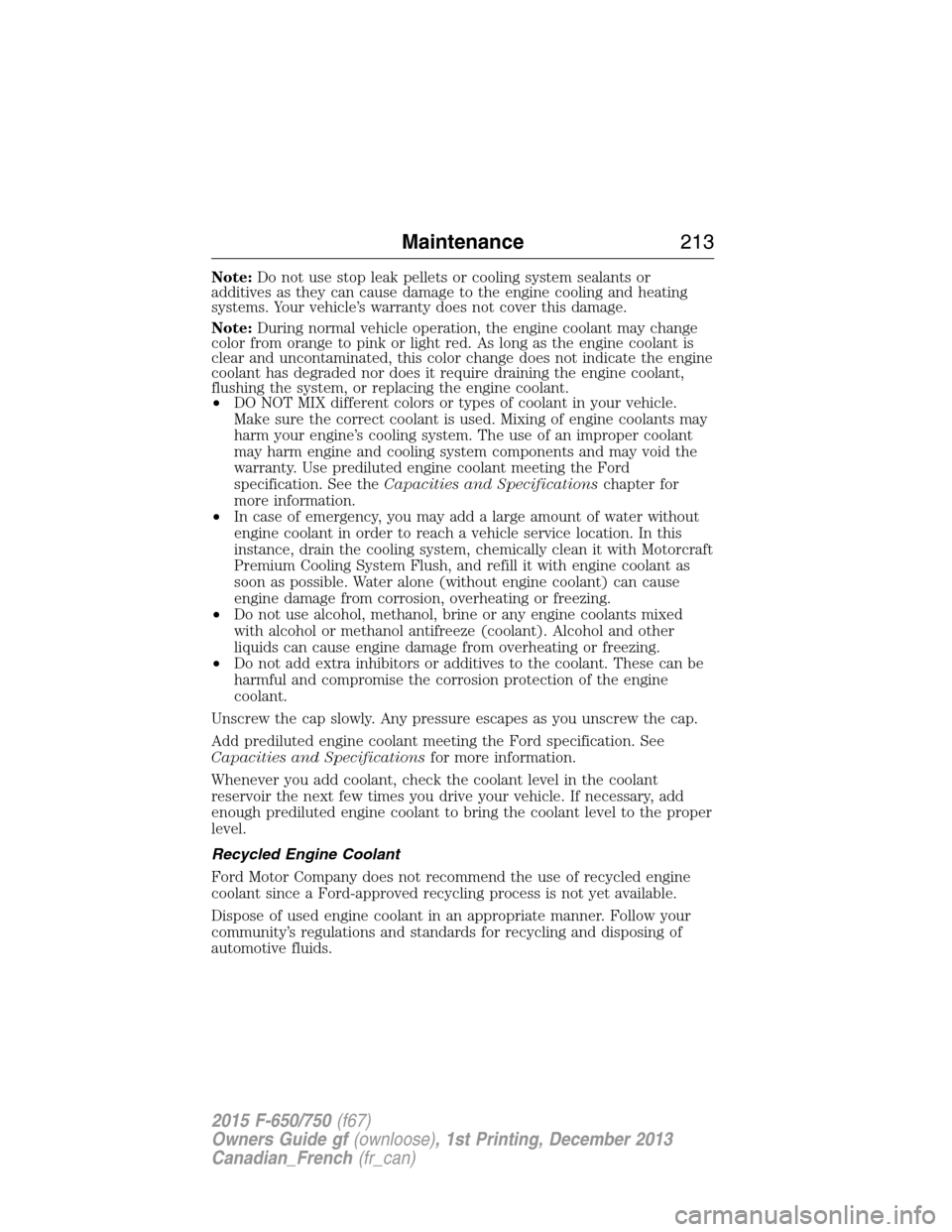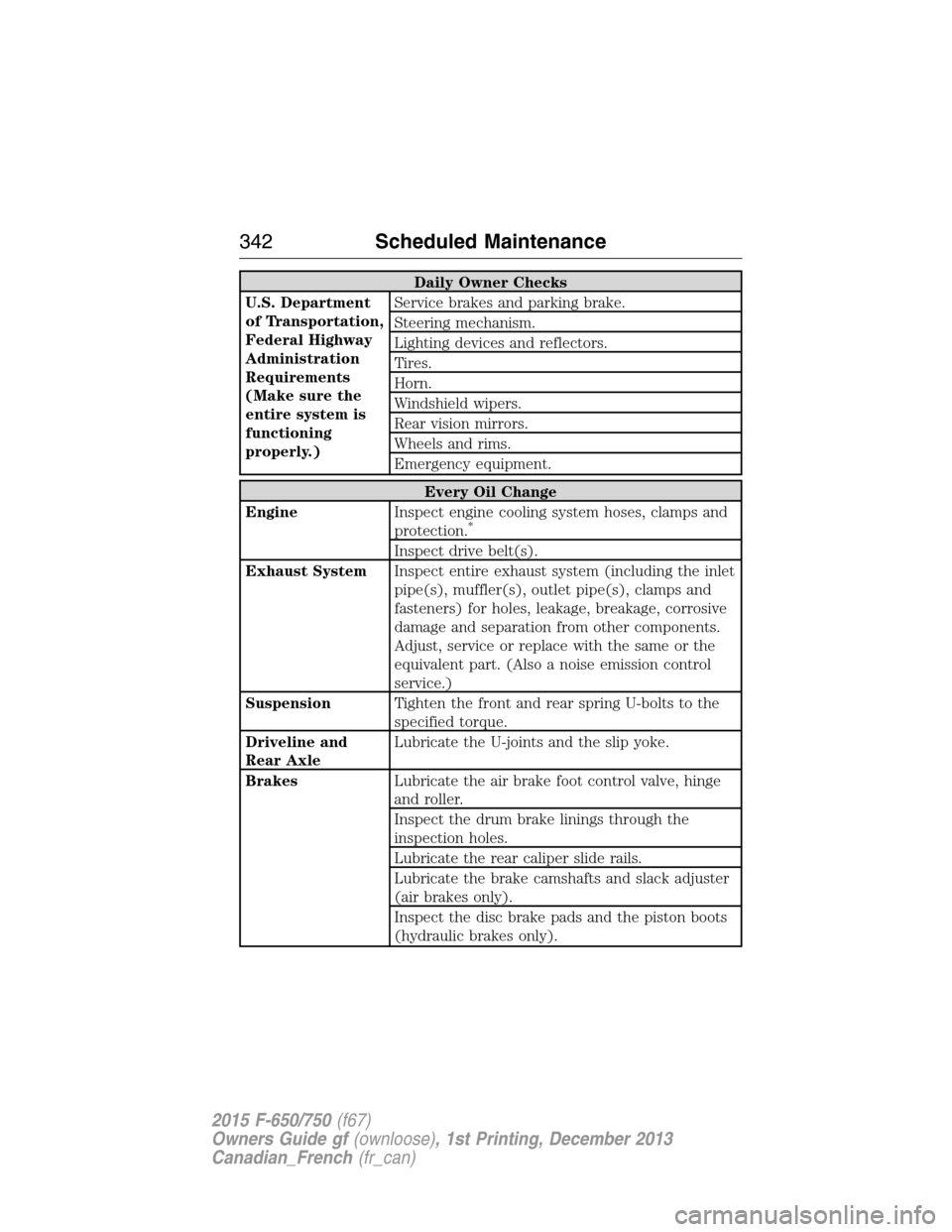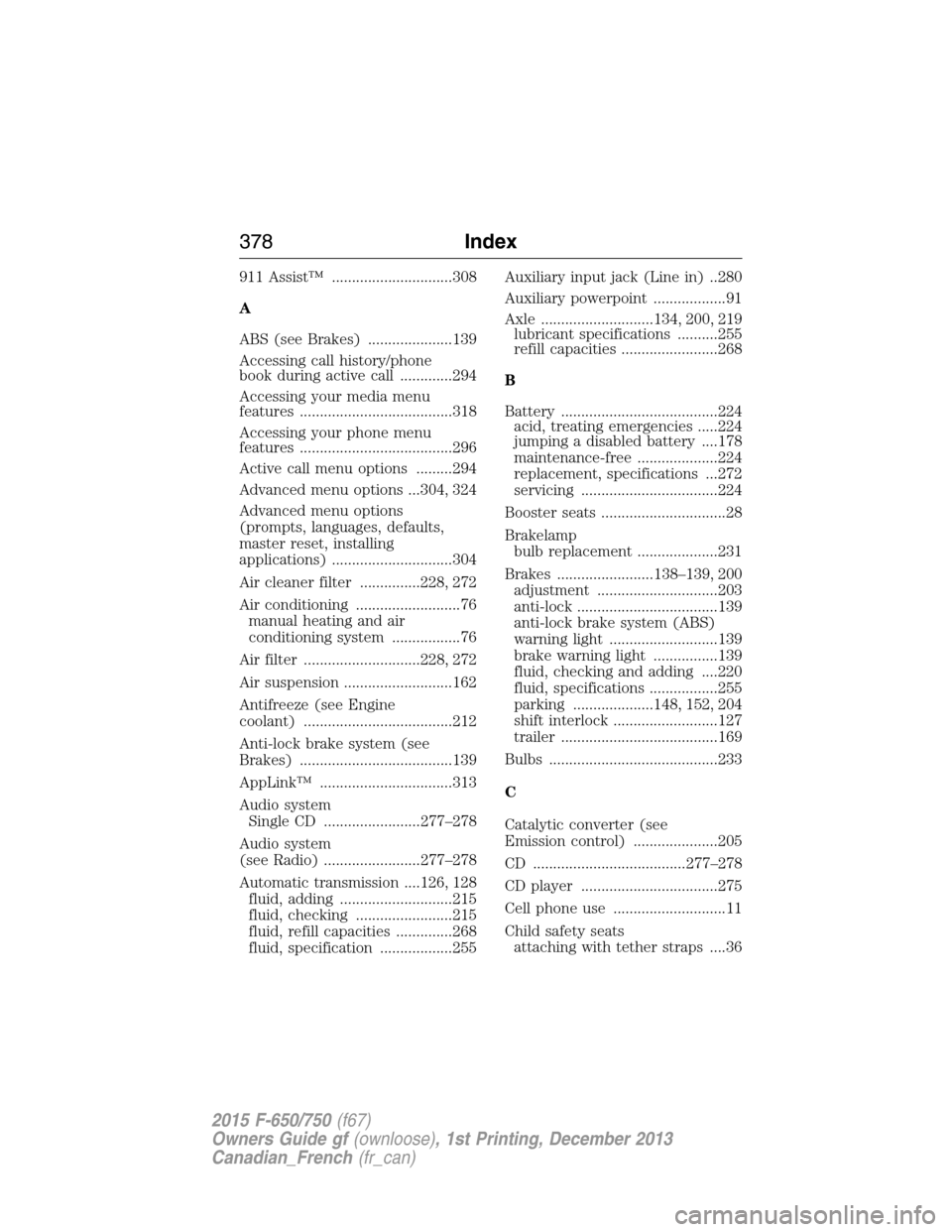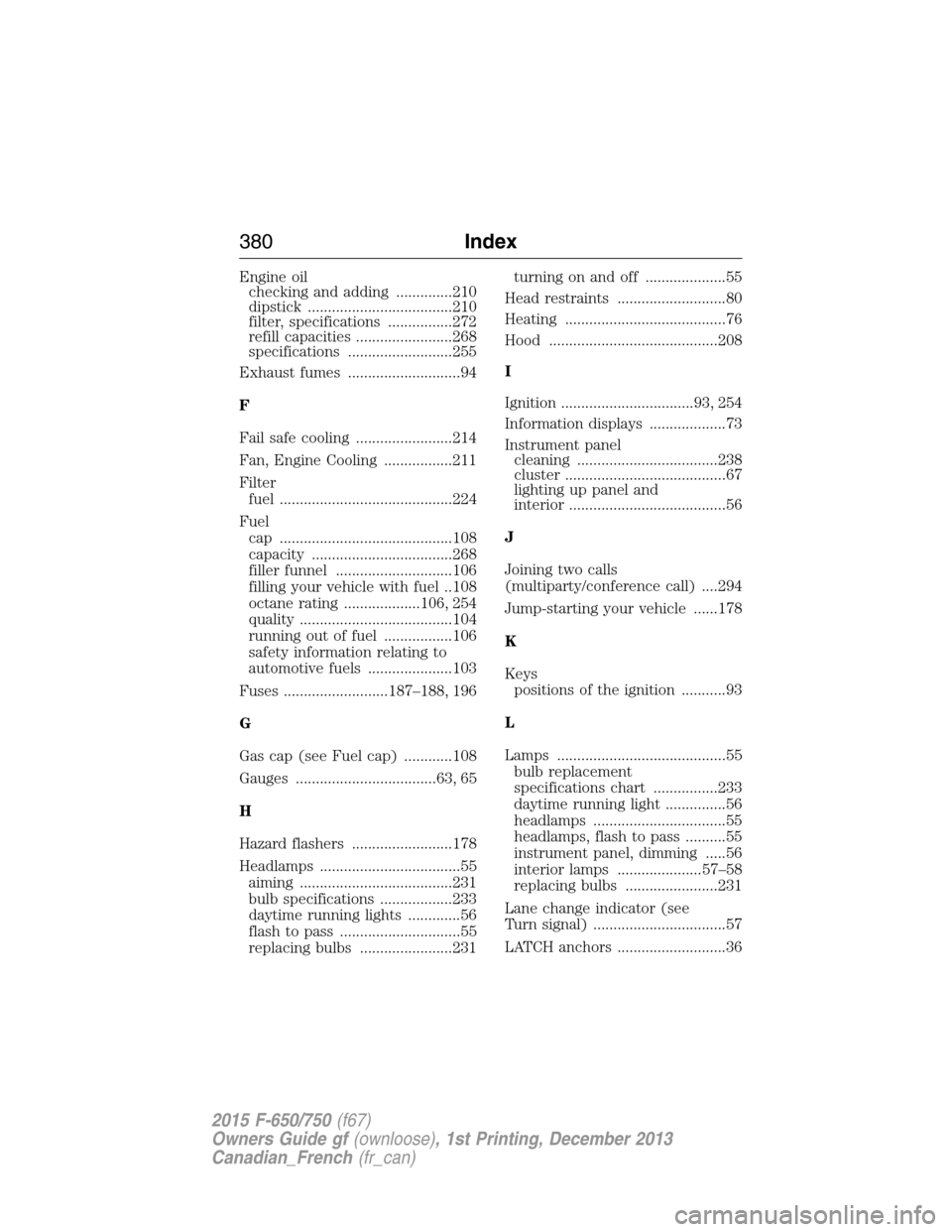check engine light FORD F650 2015 13.G User Guide
[x] Cancel search | Manufacturer: FORD, Model Year: 2015, Model line: F650, Model: FORD F650 2015 13.GPages: 384, PDF Size: 4.95 MB
Page 141 of 384

WARNING:Do not drive or continue to drive if the low air
pressure buzzer is sounding or the brake warning light is lit.
These warnings indicate that air pressure is not to normal operating
level. Continued use of the vehicle could result in loss of braking ability.
WARNING:Avoid repeated light application of the brake pedal.
This depletes air pressure faster and could result in loss of
braking capability.
Periodically check the air pressure
gauge while driving. Pressure should
range between approximately
100–125 psi (690–862 kPa). The air
compressor governor cut-in and
cutout pressure settings are set at
the factory and are not adjustable.
When air pressure is insufficient (below 60 psi [414 kPa]), a
warning light illuminates and a buzzer sounds when the ignition
is in the on position.
This may happen because excessive brake applications are depleting the
system air pressure. If this condition occurs, stop driving your vehicle
until the compressor has fully recharged the air system.
WARNING:Do not move the vehicle when the air pressure is
insufficient because the brake system may be inoperative.
Select a gear ratio to help slow your vehicle before descending grades.
Supplementing with brakes, as required, help to safely slow the vehicle
and avoids overspeeding the engine.
Air Chamber Stroke Indication
Air chamber push rods have orange stroke indicator markers that warn
when the braking system requires adjustment or repair. The painted
orange indicator is on the air chamber push rod at the slack adjuster
stroke dimension that requires service when visible during brake
application.
140Brakes
2015 F-650/750(f67)
Owners Guide gf(ownloose), 1st Printing, December 2013
Canadian_French(fr_can)
Page 199 of 384

Quality service parts are available through an authorized dealer. If dealer
parts are not used, make sure the replacement parts are of equivalent
quality.
WARNING:The use of inferior parts can adversely affect the
quality and reliability of your vehicle which, in turn, can result in
property damage, personal injury or death.
To avoid damage to your vehicle’s electrical components before electric
welding:
•Disconnect both battery cables.
•Attach the welder ground cable as close as possible to the part being
welded.
•We recommend temporarily removing the component if welding close
to an electrical component.
Follow the checks and services in theScheduled Maintenancechapter.
Have an authorized dealer or service center inspect your vehicle at least
once a year. Remember that regular maintenance and inspections usually
prevent serious problems from developing later.
If the owner or operator of the vehicle is a skilled technician and intends
on performing the vehicle maintenance and service, he is strongly urged
to purchase a service manual.
Electrical System
Periodically inspect electrical connectors on the outside of the cab and
on the engine and frame for corrosion and tightness. Exposed terminals,
such as the fuel sender, cranking motor, alternator and feed-through
studs, should be cleaned and re-coated with a lubricant sealing grease
such as Motorcraft Silicone Brake Caliper Grease and Dielectric
Compound XG-3, or equivalent. This should include the ground cable
connector for batteries, engine and cab as well as the jump-starting stud.
Accessory Feed Connections
Vehicle electrical systems are complex and often include powertrain
components, such as engine and transmission controls, instrument panels
and ABS. While most systems operate on battery voltage (12 volts),
some systems can be as high as 90 volts or as low as five volts. See the
Electrical Circuit Diagram Manuals,available from your vehicle’s
manufacturer, to make sure that any extra body lights and accessory
connections to circuits are both appropriate and not overloaded. Do not
make modifications to any vehicle control system without first contacting
an authorized dealer.
198Maintenance
2015 F-650/750(f67)
Owners Guide gf(ownloose), 1st Printing, December 2013
Canadian_French(fr_can)
Page 213 of 384

Gasoline Engine
Checking the Engine Coolant
When the engine is cold, check the concentration and level of engine
coolant at the intervals listed in theScheduled Maintenancechapter.
Note:Make sure that the level is between the MIN and MAX marks on
the coolant reservoir.
Note:Coolant expands when it is hot. The level may extend beyond the
MAX mark.
Note:If the level is at the MIN mark, below the MIN mark, or empty,
add coolant immediately. SeeAdding engine coolantin this section.
Note:For best results, coolant concentration should be tested with a
refractometer such as Rotunda tool 300-ROB75240 available from an
authorized dealer. Ford does not recommend the use of hydrometers or
coolant test strips for measuring coolant concentrations.
Note:Automotive fluids are not interchangeable; do not use engine
coolant, antifreeze or windshield washer fluid outside of its specified
function and vehicle location.
Adding Engine Coolant
WARNING:Do not add engine coolant when the engine is hot.
Steam and scalding liquids released from a hot cooling system
can burn you badly. Also, you can be burned if you spill coolant on hot
engine parts.
WARNING:Do not put engine coolant in the windshield washer
fluid container. If sprayed on the windshield, engine coolant
could make it difficult to see through the windshield.
WARNING:To reduce the risk of personal injury, make sure the
engine is cool before unscrewing the coolant pressure relief cap.
The cooling system is under pressure; steam and hot liquid can come
out forcefully when the cap is loosened slightly.
WARNING:Do not add coolant further than the MAX mark.
212Maintenance
2015 F-650/750(f67)
Owners Guide gf(ownloose), 1st Printing, December 2013
Canadian_French(fr_can)
Page 214 of 384

Note:Do not use stop leak pellets or cooling system sealants or
additives as they can cause damage to the engine cooling and heating
systems. Your vehicle’s warranty does not cover this damage.
Note:During normal vehicle operation, the engine coolant may change
color from orange to pink or light red. As long as the engine coolant is
clear and uncontaminated, this color change does not indicate the engine
coolant has degraded nor does it require draining the engine coolant,
flushing the system, or replacing the engine coolant.
•DO NOT MIX different colors or types of coolant in your vehicle.
Make sure the correct coolant is used. Mixing of engine coolants may
harm your engine’s cooling system. The use of an improper coolant
may harm engine and cooling system components and may void the
warranty. Use prediluted engine coolant meeting the Ford
specification. See theCapacities and Specificationschapter for
more information.
•In case of emergency, you may add a large amount of water without
engine coolant in order to reach a vehicle service location. In this
instance, drain the cooling system, chemically clean it with Motorcraft
Premium Cooling System Flush, and refill it with engine coolant as
soon as possible. Water alone (without engine coolant) can cause
engine damage from corrosion, overheating or freezing.
•Do not use alcohol, methanol, brine or any engine coolants mixed
with alcohol or methanol antifreeze (coolant). Alcohol and other
liquids can cause engine damage from overheating or freezing.
•Do not add extra inhibitors or additives to the coolant. These can be
harmful and compromise the corrosion protection of the engine
coolant.
Unscrew the cap slowly. Any pressure escapes as you unscrew the cap.
Add prediluted engine coolant meeting the Ford specification. See
Capacities and Specificationsfor more information.
Whenever you add coolant, check the coolant level in the coolant
reservoir the next few times you drive your vehicle. If necessary, add
enough prediluted engine coolant to bring the coolant level to the proper
level.
Recycled Engine Coolant
Ford Motor Company does not recommend the use of recycled engine
coolant since a Ford-approved recycling process is not yet available.
Dispose of used engine coolant in an appropriate manner. Follow your
community’s regulations and standards for recycling and disposing of
automotive fluids.
Maintenance213
2015 F-650/750(f67)
Owners Guide gf(ownloose), 1st Printing, December 2013
Canadian_French(fr_can)
Page 242 of 384

Body
•Wash your vehicle thoroughly to remove dirt, grease, oil, tar or mud
from exterior surfaces, rear-wheel housing and the underside of the
front fenders.
•Periodically wash vehicles stored in exposed locations.
•Touch-up raw or primed metal to prevent rust.
•Cover chrome and stainless steel parts with a thick coat of auto wax
to prevent discoloration. Re-wax as necessary when you wash your
vehicle.
•Lubricate all hood and door hinges and latches with light grade oil.
•Cover interior trim to prevent fading.
•Keep all rubber parts free from oil and solvents.
Engine
•Change the engine oil and filter before storage. Used engine oil
contains contaminates that may cause engine damage.
•Start the engine every 15 days. Run at fast idle until it reaches
normal operating temperature.
•With your foot on the brake, shift through all the gears while the
engine is running.
Fuel System
Fill the fuel tank(s) with high-quality fuel until the first automatic
shutoff of the fuel pump nozzle.
Cooling System
•Protect against freezing temperatures.
•When removing vehicle from storage, check coolant fluid level.
Confirm there are no cooling system leaks, and fluid is at the
recommended level.
Battery
Note:If battery cables are disconnected, it is necessary to reset memory
features.
•Check and recharge as necessary. Keep connections clean.
•If storing your vehicle for more than 30 days without recharging the
battery, it may be advisable to disconnect the battery cables to make
sure battery charge does not lose its charge.
Brakes
•Make sure to release the brakes and parking brake fully.
Vehicle Care241
2015 F-650/750(f67)
Owners Guide gf(ownloose), 1st Printing, December 2013
Canadian_French(fr_can)
Page 343 of 384

Daily Owner Checks
U.S. Department
of Transportation,
Federal Highway
Administration
Requirements
(Make sure the
entire system is
functioning
properly.)Service brakes and parking brake.
Steering mechanism.
Lighting devices and reflectors.
Tires.
Horn.
Windshield wipers.
Rear vision mirrors.
Wheels and rims.
Emergency equipment.
Every Oil Change
EngineInspect engine cooling system hoses, clamps and
protection.
*
Inspect drive belt(s).
Exhaust SystemInspect entire exhaust system (including the inlet
pipe(s), muffler(s), outlet pipe(s), clamps and
fasteners) for holes, leakage, breakage, corrosive
damage and separation from other components.
Adjust, service or replace with the same or the
equivalent part. (Also a noise emission control
service.)
SuspensionTighten the front and rear spring U-bolts to the
specified torque.
Driveline and
Rear AxleLubricate the U-joints and the slip yoke.
BrakesLubricate the air brake foot control valve, hinge
and roller.
Inspect the drum brake linings through the
inspection holes.
Lubricate the rear caliper slide rails.
Lubricate the brake camshafts and slack adjuster
(air brakes only).
Inspect the disc brake pads and the piston boots
(hydraulic brakes only).
342Scheduled Maintenance
2015 F-650/750(f67)
Owners Guide gf(ownloose), 1st Printing, December 2013
Canadian_French(fr_can)
Page 379 of 384

911 Assist™ ..............................308
A
ABS (see Brakes) .....................139
Accessing call history/phone
book during active call .............294
Accessing your media menu
features ......................................318
Accessing your phone menu
features ......................................296
Active call menu options .........294
Advanced menu options ...304, 324
Advanced menu options
(prompts, languages, defaults,
master reset, installing
applications) ..............................304
Air cleaner filter ...............228, 272
Air conditioning ..........................76
manual heating and air
conditioning system .................76
Air filter .............................228, 272
Air suspension ...........................162
Antifreeze (see Engine
coolant) .....................................212
Anti-lock brake system (see
Brakes) ......................................139
AppLink™ .................................313
Audio system
Single CD ........................277–278
Audio system
(see Radio) ........................277–278
Automatic transmission ....126, 128
fluid, adding ............................215
fluid, checking ........................215
fluid, refill capacities ..............268
fluid, specification ..................255Auxiliary input jack (Line in) ..280
Auxiliary powerpoint ..................91
Axle ............................134, 200, 219
lubricant specifications ..........255
refill capacities ........................268
B
Battery .......................................224
acid, treating emergencies .....224
jumping a disabled battery ....178
maintenance-free ....................224
replacement, specifications ...272
servicing ..................................224
Booster seats ...............................28
Brakelamp
bulb replacement ....................231
Brakes ........................138–139, 200
adjustment ..............................203
anti-lock ...................................139
anti-lock brake system (ABS)
warning light ...........................139
brake warning light ................139
fluid, checking and adding ....220
fluid, specifications .................255
parking ....................148, 152, 204
shift interlock ..........................127
trailer .......................................169
Bulbs ..........................................233
C
Catalytic converter (see
Emission control) .....................205
CD ......................................277–278
CD player ..................................275
Cell phone use ............................11
Child safety seats
attaching with tether straps ....36
378Index
2015 F-650/750(f67)
Owners Guide gf(ownloose), 1st Printing, December 2013
Canadian_French(fr_can)
Page 381 of 384

Engine oil
checking and adding ..............210
dipstick ....................................210
filter, specifications ................272
refill capacities ........................268
specifications ..........................255
Exhaust fumes ............................94
F
Fail safe cooling ........................214
Fan, Engine Cooling .................211
Filter
fuel ...........................................224
Fuel
cap ...........................................108
capacity ...................................268
filler funnel .............................106
filling your vehicle with fuel ..108
octane rating ...................106, 254
quality ......................................104
running out of fuel .................106
safety information relating to
automotive fuels .....................103
Fuses ..........................187–188, 196
G
Gas cap (see Fuel cap) ............108
Gauges ...................................63, 65
H
Hazard flashers .........................178
Headlamps ...................................55
aiming ......................................231
bulb specifications ..................233
daytime running lights .............56
flash to pass ..............................55
replacing bulbs .......................231turning on and off ....................55
Head restraints ...........................80
Heating ........................................76
Hood ..........................................208
I
Ignition .................................93, 254
Information displays ...................73
Instrument panel
cleaning ...................................238
cluster ........................................67
lighting up panel and
interior .......................................56
J
Joining two calls
(multiparty/conference call) ....294
Jump-starting your vehicle ......178
K
Keys
positions of the ignition ...........93
L
Lamps ..........................................55
bulb replacement
specifications chart ................233
daytime running light ...............56
headlamps .................................55
headlamps, flash to pass ..........55
instrument panel, dimming .....56
interior lamps .....................57–58
replacing bulbs .......................231
Lane change indicator (see
Turn signal) .................................57
LATCH anchors ...........................36
380Index
2015 F-650/750(f67)
Owners Guide gf(ownloose), 1st Printing, December 2013
Canadian_French(fr_can)